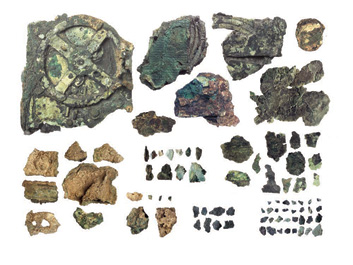The people of Ancient Greece were able to develop a calendar of their own. This was as early as the early Classical Age. The Ancient Greek calendar was very useful and worthy of value. But despite everything, the Ancient Greek calendar was complex, troublesome, and confusing. To make it clear, a comparison may be drawn between the Ancient Greek calendar and the cities of Ancient Greece. It bore a resemblance to religious rituals, customs, and norms. But each state had its separate version of the Ancient Greek calendar. The Ancient Greek calendar followed a lunisolar model and system. There were two key characteristics of the Ancient Greek calendar. They were that the calendar had twelve months and it had periodic intercalation of the thirteenth. Each Ancient Greek city-state had a unique calendar of its own. They have been discussed in detail below.

Ancient Greek Calendar: Athenian Style
Out of all the Ancient Greek calendars, the Athenian style of the Ancient Greek calendar was the most popular and in use. It is also studied in detail. The basic characteristics remained the same. The beginning of the year was with summer. It was the opening season of the Athenian calendar. Hekatombion was the opening month of the calendar which signified the start of the year. There were eleven other months in that calendar which were as follows- Metageitnion, Boedromion, Pyanepsion, Miamakterion, Poseidon, Gamelion, Anthesterion, Elaphebolion, Munychion, Thargelion, and Skirophorion.
Ancient Greek Calendar: Styles Found in Other City-States
The beginning of the year was at different times for the different city-states of Ancient Greece. From Delos to Sparta and Macedonia, it was altogether different in various aspects. Like, for example, Delos started their year in winter, while for Sparta and Macedonia, the beginning of the year was considered to be in the fall. However, no one of these calendars was considered to be flawless. The Athenians were not willing to consistently stick to a regular calendar. For them, their experimental nature came prior to their astronomical knowledge. This was not due to their lack of astronomical knowledge. The Athenians were rather backward in their approach, in the case of the Athenian Greek calendar. It seems like they did not have any specified formula for determining the duration of the months. They followed the alternative method of 29 to 30 days for determining the length of a particular month. This calendar was called the festive calendar. It was very specific in nature and all the Ancient Greek festivities were marked and figured out using these calendars. The Athenians had an alternative calendar for political purposes. This was a very confusing system of recording time. Thus the maturity and advanced thought process of the Athenians and Ancient Greeks was seen in the making and designing calendars of the Ancient Greeks.

Historians and scholars who have tried to comprehend this system, have not succeeded in doing so. This proves the difficulty and problems one has to face while enumerating and evaluating the various kinds of calendars from Ancient Greece.
Significance of the Calendar in the Olympiad
The Olympiad confirms that the authors and writers calculated the beginning of the year with the help of their local conventions, such as summer, winter, spring, or fall. For the Byzantine authors, who used the Olympiad, the year begins on the 1st of September. The eras which have been used by the Ancient Greek writers are of little importance. The only worthwhile is the Trojan Era which deals with the destruction of Troy and is hugely relevant for the historical denominations. However, this period and date are conventional and are not in relation to the world order. A wide variety of starting points have been found but the most popular and relevant is the one developed by Eratosthenes with the setting being around 407 years before the first Olympiad was done in 1183 BCE.
Timeline of Events from the Ancient Greek Period
1. 776 BCE: The first Olympic game was held.
2. 650 BCE: Corinth was captured.
3. 508 BCE: Democracy was started in Athens. It was a prelude to the modern concept of democracy
4. 500 BCE: Onset of the early Classical period.
5. 490 BCE: Ancient Greece defeated Persia.
6. 472 BCE: The theatre was founded and became popular.
7. 432 BCE: Parthenon was completed.
8. 338 BCE: Philip II took charge of Ancient Greece.
9. 138BCE: Rome conquered Ancient Greece,
This was the series that has been found in the Ancient Greek calendar, which has been sorted in chronological order.
Conclusion
The calendars of Ancient Greece, namely those of the Ancient Greek peninsula, Ionia, and the Greek islands were made, keeping a focus on Athens. They were diverse and also fragmented, keeping in mind and reflecting the political fragmentation of the Ancient Greek world. Most of these calendars were lunar in nature, except for the Prytanic calendar or Athens. It was a particular calendar of Athens that was used alongside Athens’ archontic and lunar calendar. Political tampering with the lunar calendars was rampant in Ancient Greece which affected the question of the legitimacy of their use.
Most of the Ancient Greek festival calendars were lunar in origin and were aligned with the sun through various intercalary cycles, which were lunisolar in nature. There was a particular calendar for each city-state whose month names had some, little, or no similarity with those of the other city-states. Names of gods or festivals held in the honor of a given month were considered to be sacred in character for the calendar. New Year’s Day was also different for the various months of the calendars, generally depending on the first new moon after one of the four tropical points. The calendar is also useful in understanding the situation and setting of the sacred structures of Ancient Greece. The introduction of the Roman Julian calendar also hardly brought about any uniformity to the eastern calendars of Ancient Greece.